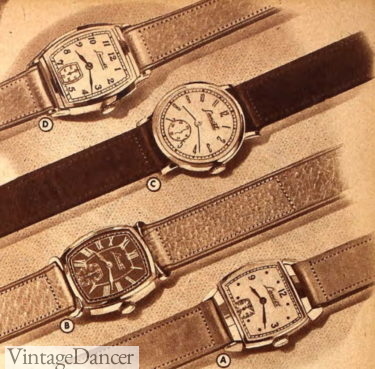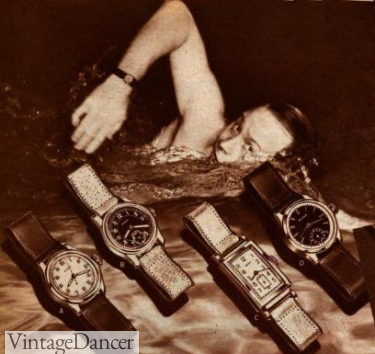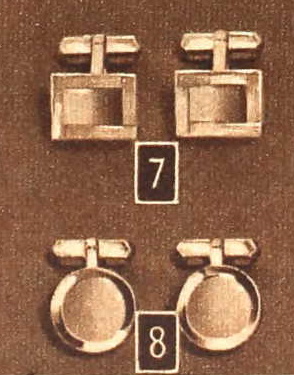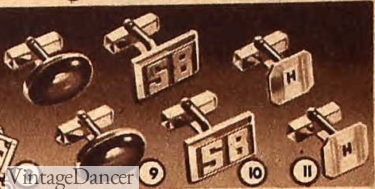Part two of the article on 1940s men’s fashion continues with a look at accessories in menswear. Men’s belts or suspenders, cufflinks, jewelry, pocket squares, watches, gloves, and scarves were all worn by men during the 1940s. These are important parts of 1940s men’s clothing, but are usually overlooked in discussions about men’s fashion.
1940s men’s accessories were often the only bit of bright color in his wardrobe. Many men in the early years collected matching sets of accessories, even down to the underwear. This didn’t last long, although coordinating two accessories to each other remained common practice.
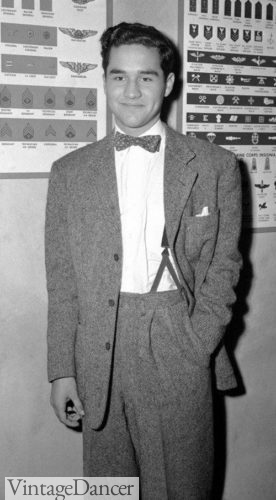
Charles Chaplin Jr. 1943
In this article we will go over men’s 1940s accessories:
- Suspenders
- Belts
- Watches/ Pocket Watches
- Cufflinks / Tie Clips
- Rings and other Jewelry
- Pocket Square/ Handkerchief
- Muffler Scarves
- Gloves
- more accessories…
1940s Men’s Suspenders
Men in the ’40s still wore both suspenders and belts, although sales for suspenders declined greatly over the decade. Suspenders, also called braces, mostly still buttoned on with sliders to tighten or loosen them. Clip-on suspenders were an option as well, just not as popular yet.
The first suspenders with stretch plastic elastic on the ends provided a bit more ease in movement, although it would be another decade before they became preferred over leather, nylon or cotton webbing.

1944 Men’s dress and work suspenders
For dress suspenders, the width remained around 3/4″ to 1-1/3″ inches and for work strength suspenders a 1 1/2″ to 2″ thickness was preferred. Metal bits were often colored to match the straps.
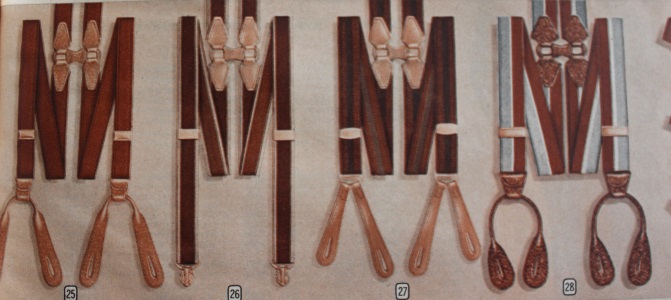
1947 Men’s Striped Suspenders
For men that choose suspenders, the look was anything but mundane. Instead, suspenders were designed in wide stripes, big checks, and other bold patterns. Popular colors were maroon, brown, blue, green with white or cream stripes. It wasn’t uncommon to buy suspenders, belts, socks, and ties in a matching set. Both Y, X and T shaped suspenders were worn in the 1940s. The fight to keep suspenders from sliding off shoulders was a daily battle.
Shop men’s vintage style suspenders and braces here.
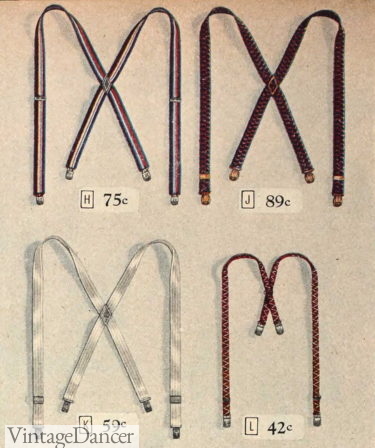
1946 boys and teen clip on suspenders
1940s Men’s Belts
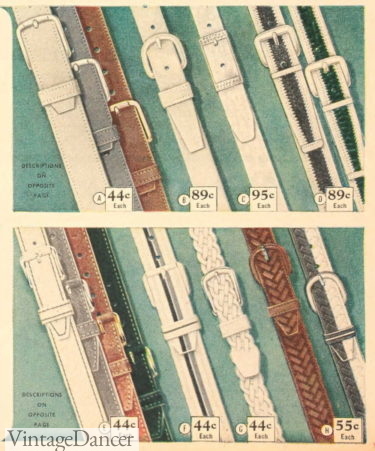
1940 men’s spring belts
Men’s belts picked up in fashion in the 1930s and continued into the 1940s. At first they were thin and placed in the center of men’s wide waist bands. They were about 3/4″ to 1-1/4″ or so wide with small oval metal buckles that were often covered in matching leather.
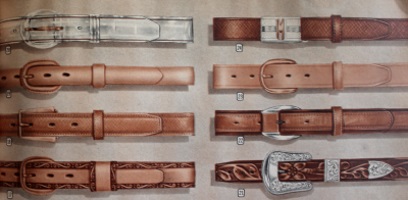
1947 Men’s plain leather belts (top left is a clear plastic belt.)
Some more youthful designs featured clear plastic buckles with specks of glitter. Leather belts were tan, brown, or black and could be plain, pebbled, braided, or tooled with Western embossing. The Western motif with silver buckles was trendy on all men, country and city.
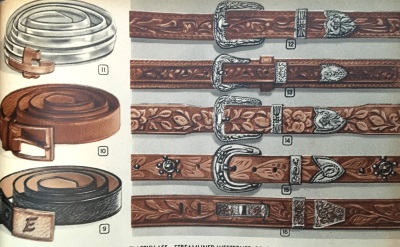
1948 Men’s leather tooled belts (R) Plastic belt (Top), basic leather belt (Middle) and military belt( Lower)
Sportier belts were either made of woven nylon or lined with nylon behind the leather. It was a more casual style, perfect for sport shirts and colored pants. Military style belt buckles were also a casual look, many times with a stamped initial on the face.
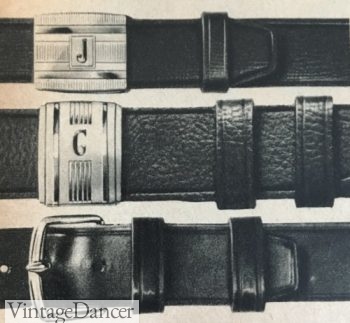
1940s military buckle men’s belts
1940s Men’s Watches
- 1942 leather watches
- 1941 waterproof sport watches
Now that everyone carries their cell phones with built-in clocks around with them, watches are falling by the wayside. But during the ‘40s, they were a requirement for men. There were circular faces, but a square or rectangle was much more stylish. They had thin gold trim and a plain brown, black or tan leather bands. The band was much thinner than you’re used to seeing, at about a half inch wide. They could be smooth leather or lightly pebbled.
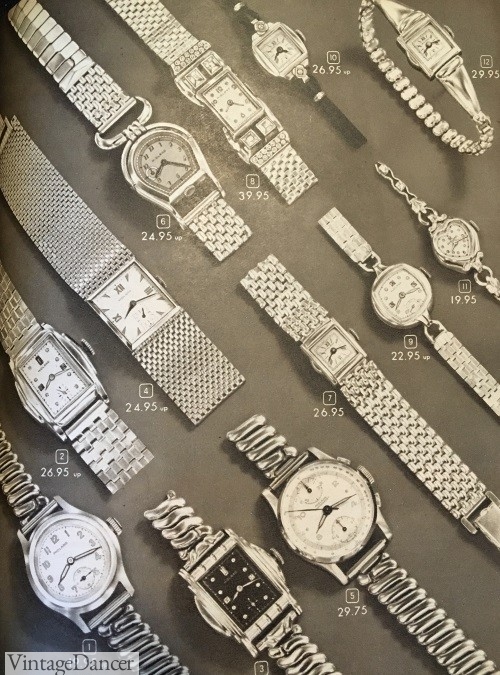
1948 Men’s and Women’s Metal Band Watches
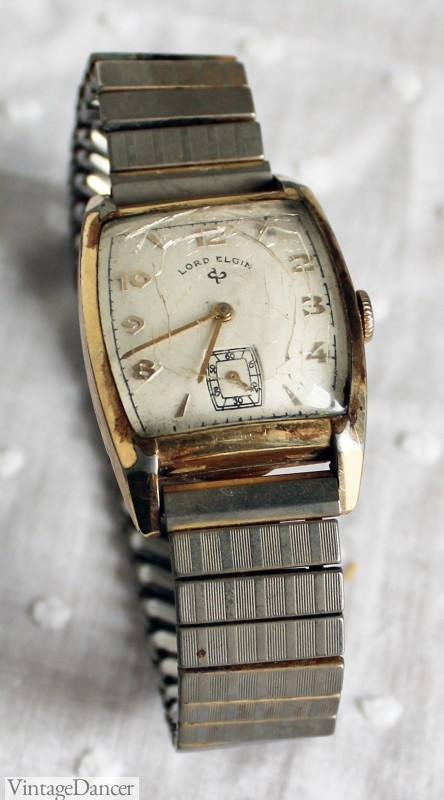
My grandfathers Elgin watch from the 1940s. Gold face with steel band.
Metal band watches were the other popular style for men. Gold, silver or steel (more economical) metal was woven like mesh or in a basket-weave. Some also had an expansion band designed to open wider and close up around the wrist. The cases were usually gold, while the rest of the body could be gold or steel. The watch face was clean and modern, and the crystal was usually flat but fancier versions could be domed slightly. See some more examples of vintage men’s 1940s watches.
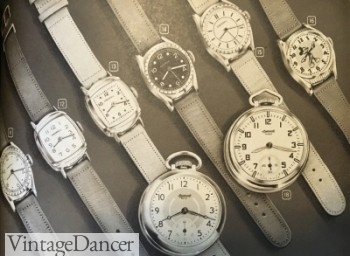
1948 Men’s Leather Brand Watches
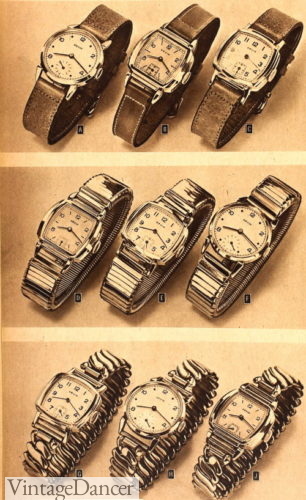
1947 leather and metal men’s watches
What about pocket watches? Some men continued to carry them. Many well dressed gangsters especially liked them hanging from a watch chain attached to their vest or suit coat. Zoot suit wearing rebels also wore them with extra along chains hanging down the the knee. Pocket watches were too impractical for the working man.
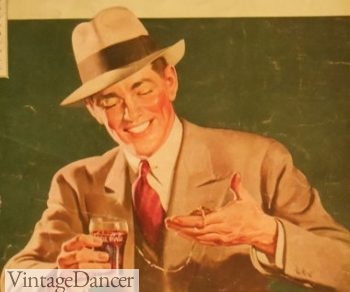
1940, man checking his pocket watch from inside his suit coat or vest.
Read more about the history of name brand watches including the Bulova, Elgin, Waltham, Hamilton, and Rolex.

1947 man pulling out his pocket watch attached to the underside of his suit coat but kept in a pocket on the inside. How confusing!
1940s Men’s Cufflinks & Tie Clips
Men’s jewelry nearly disappeared during the war years, although the military had a strong influence on designs post-war.
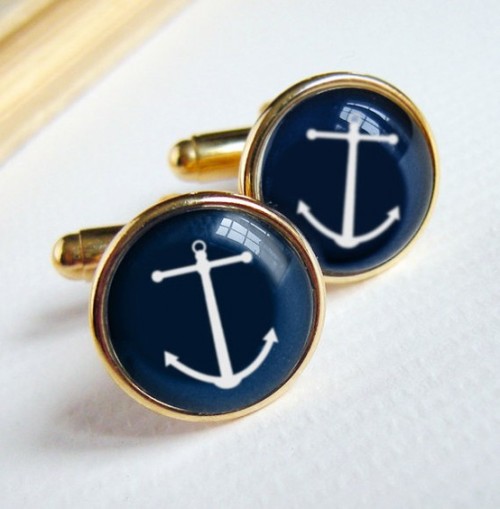
Handmade anchor cuff links in the 40s style on etsy.com
Cufflinks were almost always worn with dress shirts, especially for work or fancier occasions. They were usually round gold-toned metal with pops of color done in glass or resin. Geometric Art Deco designs were a trend during the decade, as were monogrammed initials. Navy themes were big too – an anchor or boat would be surrounded by navy. Plain circles or squares were filled with colored glass. Other cufflinks had themes like lucky horseshoes, planes, palm trees or pin up girls. Since they were worn so often, men collected many different pairs.
- 1945 cuff links
- 1942 cuff links
By the end of the ’40s, clothes were growing wider, and so did cufflinks to match. Up to 1/2-inch wide gems set in a thick gold case were not uncommon. Tie clips, too, were 1/2″ wide gold bars.

1947 men’s ID bracelets, collar bar and tie pin
Before the bold look, tie clips and collars pins were sold as a matching sets, although few men wore collar pins. Tip clips with chains were useful when a vest was not worn to hold the tie down. The clip had a pain bar or two prong clasp with a chain wrapped around the necktie. The chain often had a distinctive decoration or monogram in the middle. It could be a gemstone or up to three initials on a small plate.
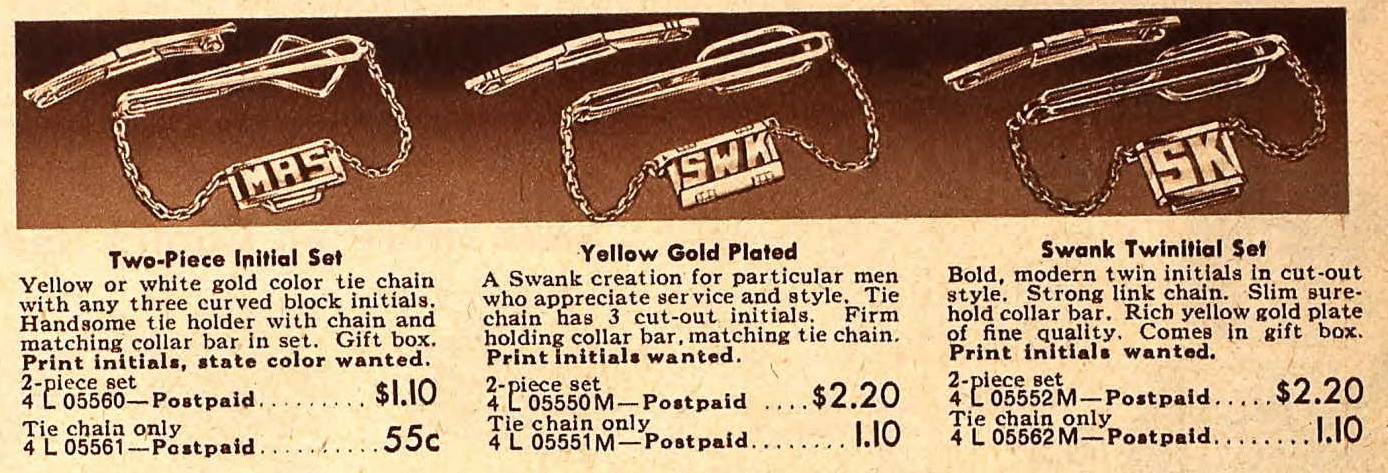
1942 monogram tie clips
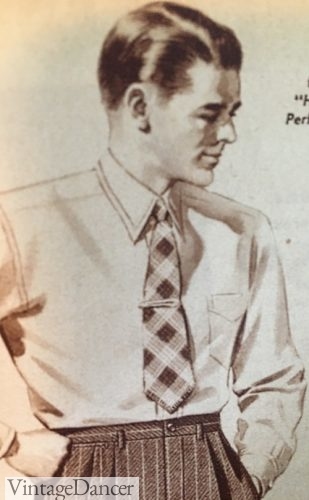
1940s tie with tie clip
1940s Men’s Jewelry
Key chains, like long watch chains in yellow gold or silver, were an older style phasing out during the 1940s. A new style of pressure clip allowed them to hook onto a belt and hang in a loop to the keys carried in the pants pocket. Sharp keys poked holes in pants so the key case, a leather wallet just for keys, was a preferred method of carrying car or office keys. Most houses were never locked, so carrying house keys was unnecessary.
Another keychain popular with youth was a short key chain fob clipped to pants pockets or belts. A pocket knife was often carried with keys and they, too, were monogrammed.
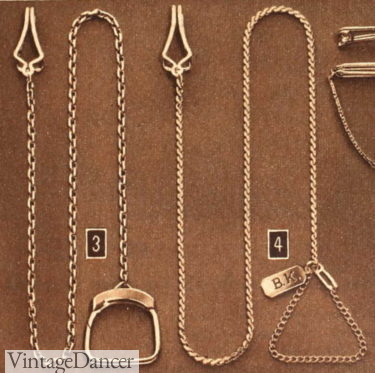
1945 key chain
The ID bracelet was the most worn jewelry piece by young men and women in the 1940s. Men’s versions featured a gold or silver plate with name or initials etched on it. The plate attached to a heavy metal chain bracelet. It was a common sign of courtship for a young man to give his girlfriend his ID bracelet to wear, although she didn’t give him hers.
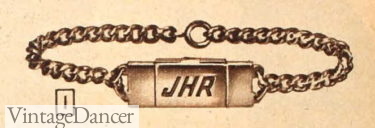
1945 ID bracelet
Rings were worn by men for two reasons. The most obvious was the wedding ring. Wedding bands were not too different from those of today. They could be a very simple undecorated band or a series of small etchings or diamond insets in the band. Matching men’s and women’s bands were quite common.
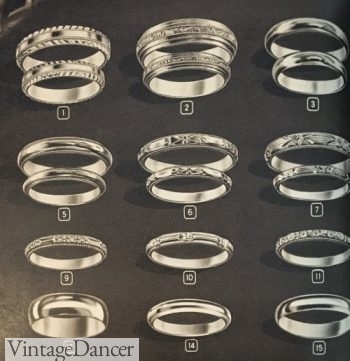
1940s men’s wedding ring sets
The other reason to wear a ring was to show membership into a club, fraternal organization, university class, or sports achievement. There were also signet rings with just one or two initials. Signet rings were usually worn on the end finger. These club rings were quite chunky and heavy. They were made of gold or silver with a raised black onyx face and accents of diamonds or other colored stones (real or fake).
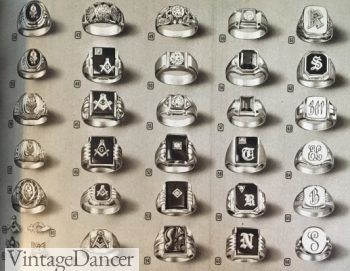
1947 men’s signet rings
1940s Men’s Pockets Square
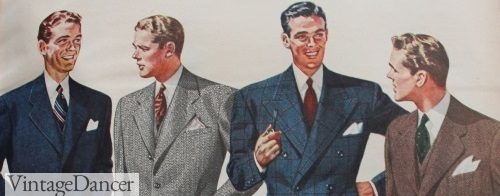
1942, two point white pocket squares were worn in every shade of suit
No 1940s suit would be complete without a pocket square, otherwise called a handkerchief. They were folded and placed in the suit chest pocket.
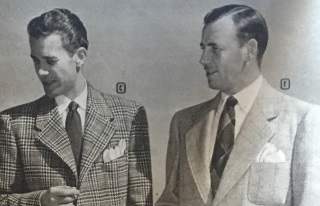
1947 irregular folded squares
In the early ’40s, there was a fad for matching pocket squares to shirts, ties, suspenders and even underwear. Needless to say, it didn’t not last long. Instead, the ’40s favored the plain white pocket square with wide hem. It complemented the wide tie knots, wide spread collar, and setback command stitching on shirt collars.
The most common type of fold was two point pocket square fold. A single point was also common. In the late ’40s, a few TV personalities made the TV fold popular. The pocket square was folded in half and then thirds and placed into the pocket so that only a 1 inch white straight band appeared above the suit pocket edge. Sometimes, a monogram was visible on the fold. Another style in 1948-49 was the irregular fold. Basically it was bunched then folded in half so that the three or so points were disheveled.
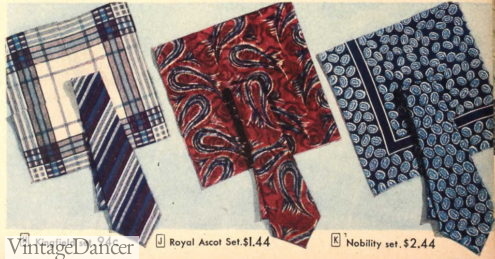
1944 matching ties and pocket squares
Don’t use a pocket square for practical purposes – keep that one, a plain white handkerchief, in your pants pocket!
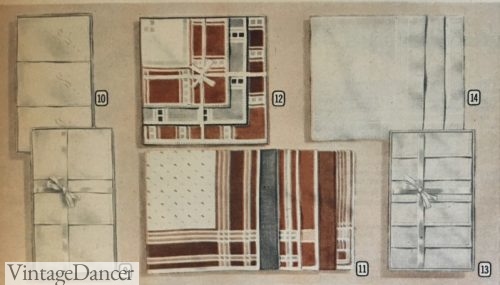
1947 men’s white and border handkerchiefs
Not all handkerchiefs were white. Border prints in muted colors such as brown, grey, blue and maroon gave men more choices and looked cleaner for longer. Handkerchiefs were usually made of Irish linen or light cotton. Silk was an option after the war, but it was not practical to use. Many handkerchiefs were monogrammed with initials and finished with a rolled hem, pearl stitch, or French seam. Most handkerchiefs during this era were handmade instead of store bought, often given as gifts or collected during travels abroad.

1947 men’s white handkerchief
1940s Men’s Scarf or Muffler
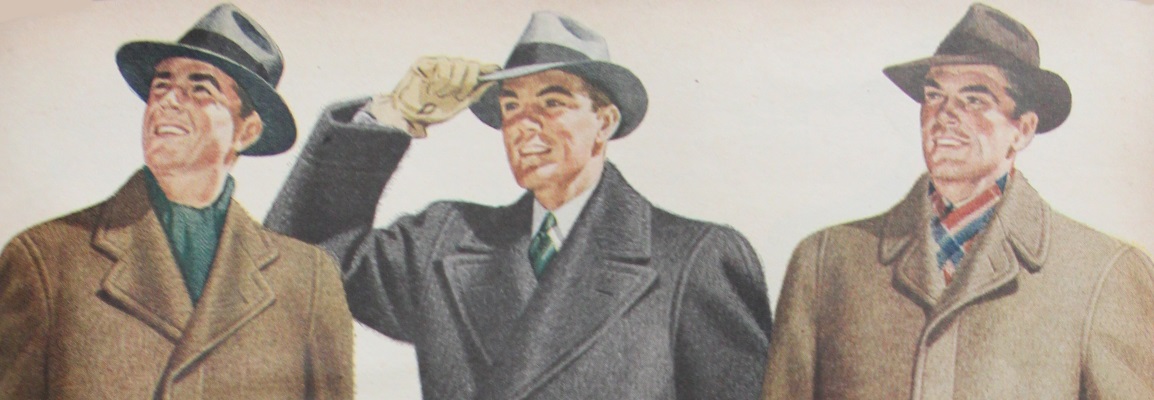
1942 mufflers/scarves in knit green (L) and red/blue plaid (R) under top coats
While a knit wool scarf provided plenty of warmth in colder climates, the most common use for a scarf in the 1940s was as an accessory. Pilots in war time would wear a white silk scarf, while at home men wore bright patterns of paisley, stripes, plaid, polka dots, and Deco prints. They were worn hung around the neck, crossed in front and tucked into the jacket or pullover vest. In many cases, a scarf was worn in place of a tie.
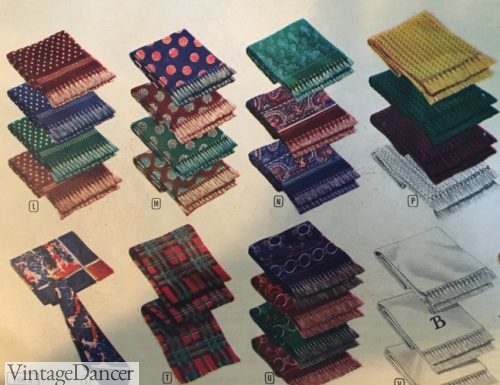
1943 colored fringe rayon silk and knit wool scarves
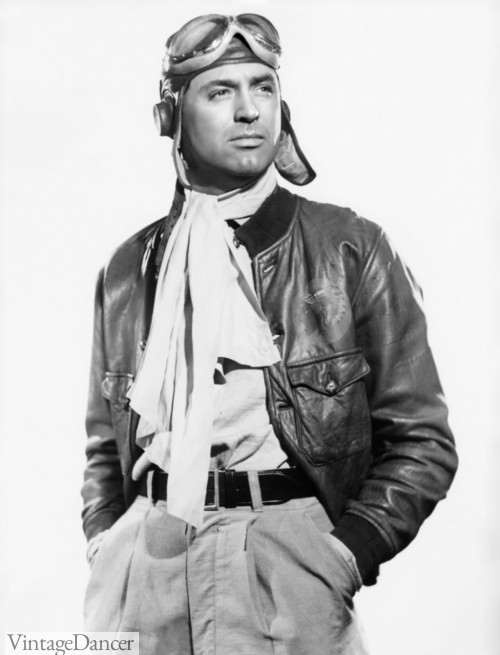
Carry Grant in military pilot attire with white silk scarf
Scarves or mufflers added a splash of color in an otherwise drab color palette of grey, tan or blue overcoats. Both business and casual clothing could use a scarf equally. Colors such as yellow plaid, red paisley, yellow paisley, wine, blue, and khaki tan were common. The white or navy blue scarf with fringe and a big monogram was a style borrowed from pilots and worn loosely over clothing, exposing the monogram. Some men’s evening wear also incorporated the white silk scarf.
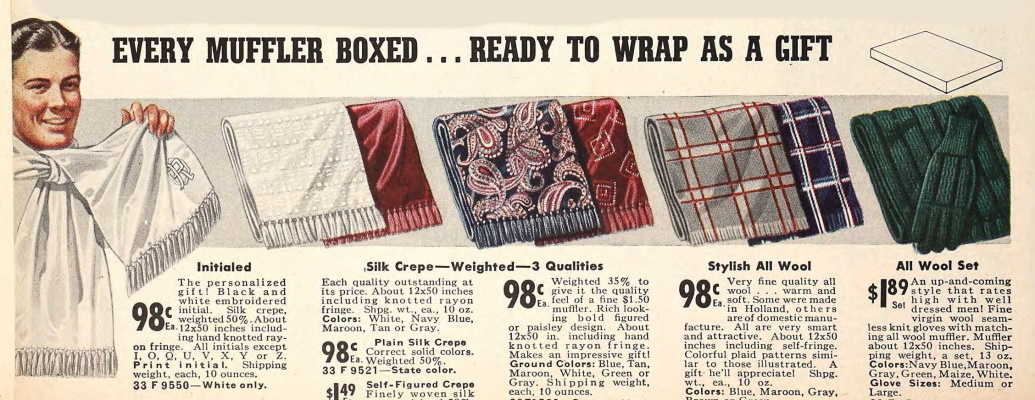
1940 mufflers- plain, paisley, or windowpane
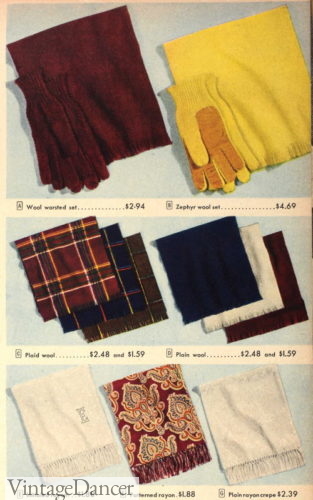
1944 scarves/mufflers
Naturally, knitting winter scarves for men was still in style in the 1940s. Short or medium long fringe was often paired with chunky rows. Some patterns had checks or stripes in the design as well.
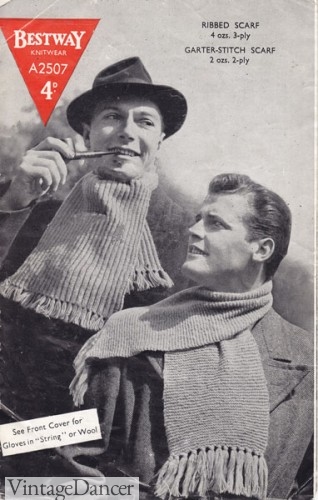
1940s Men’s Knitting pattern for Scarves
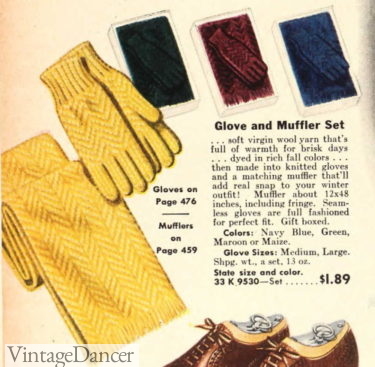
1941 colorful winter scarf and gloves sets
1940s Men’s Gloves
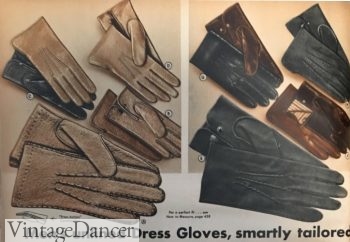
1944 men’s dress gloves
The use of day gloves, street gloves, or dress gloves seemed pointless in the 1940s. A few well dressed upper class gentlemen continued to wear them in goat skin, deerskin, horsehide or chamois. Typically, gloves would come in dark colors such as black, brown or grey. Lighter shades of tan were popular in summer or with casual sport coats.
Both lined and unlined gloves were available. Lined gloves came in fleeced rayon, cotton fleece, wool knit, rabbit fur, and lambskin wool. A single button at the wrist secured early versions. In the mid 1940s, the button disappeared or was replaced by a wrist strap and snap. The pull on style was the easiest glove to wear and has outlasted all other styles today.
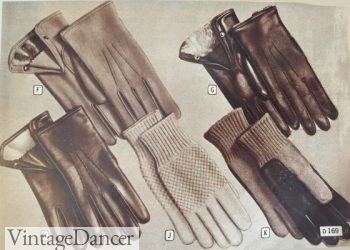
Leather or knit dress gloves/driving gloves
Gloves specifically made for driving cars were worn year-round. With a lack of heaters, cars were cold, especially the leather steering wheels. Some knit driving gloves had leather or suede palms for more grip. Driving gloves differed slightly than dress gloves by having a longer wrist. It was a design reduced down from the big 1930s gauntlet driving gloves. Learn more about vintage driving gloves here.
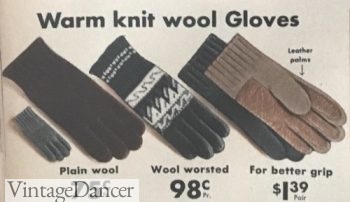
1944 mens knit gloves
Wool knit gloves and mittens were frequently handmade or purchased for a modest amount of money ($12-20 in today’s US currency). Knit gloves often matched shawls and mufflers. In the military and labor jobs, the fingerless glove helped hands stay warm while still being able to use fingers. Some mittens had one finger, the pointer finger, separated too. Mittens also came in full leather and were lined with warm materials.
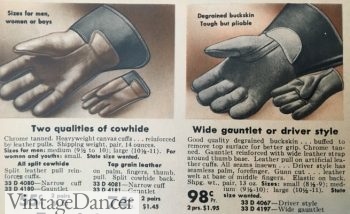
1944 men’s gauntlet work gloves and long wrist driving gloves gloves (smaller picture)
Work gloves were made of thicker horsehide, cowhide, or buckskin in a pull-on style. Some had elastic knit wrist bands to help with fit and protection. Others had a full wrist gauntlet. The lighter-weight canvas glove was good for light work, home, and gardening uses.
Learn more about men’s vintage gloves.
More men’s accessories
Some more men’s accessories history is in these articles:
- 1940s Men’s Ties – History of ties from the 1920s to 1960s.
- 1940s Men’s Socks – At the bottom of this article on men’s 1940s shoes.
- 1940s Men’s Hats – The classic styles of men’s hats.
- 1940s Men’s Suspenders – Vintage style button on or clasp suspenders in leather or elastic.
- 1940s Men’s Sunglasses and Eyeglasses
Debbie Sessions has been teaching fashion history and helping people dress for vintage themed events since 2009. She has turned a hobby into VintageDancer.com with hundreds of well researched articles and hand picked links to vintage inspired clothing online. She aims to make dressing accurately (or not) an affordable option for all. Oh, and she dances too.
